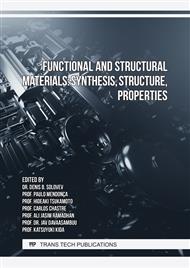[1]
Energeticheskaya strategiya Rossijskoj Federacii na period do 2035 (2020), Available at: http://www.consultant.ru/document/cons_doc_LAW_354840/feb387ba6cb412e94e5c4fd72de0228c1a68af25/
Google Scholar
[2]
E.I. Reishakhrit, Specific features of energy efficiency management at enterprises of oil processing industry, Journal of Mining Institute. 219 (2016) 490.
Google Scholar
[3]
M.A. Vasilyeva and A.A. Volchikhina, Analysis of influence of pipeline roughness dispersion on energy consumption during fluid transportation, Int. Conf. of Complex Equipment of Quality Control Lab. Nuclear Physics, vol. 1118(1), Saint-Petersburg: St. Petersburg Mining University, 012047.
DOI: 10.1088/1742-6596/1118/1/012047
Google Scholar
[4]
PJSC Transneft 2020 Annual Report of the Sustainable Development 2019: Use of Energy Resources and Energy Conservation, vol. 5, pp.127-38, Available at: https://www.transneft.ru/u/section_file/48791/verstka_oyr_rys_dlya_saita.pdf
Google Scholar
[5]
S. Braungardt, et. al., Report on behalf of DG ENER: Study evaluating the current energy efficiency policy framework in the EU and providing orientation on policy options for realising the cost-effective energyefficiency/saving potential until 2020 and beyond, Karlsruhe/Vienna/Rome: Fraunhofer Institute for Systems and Innovation Research ISI, 2014, p.200.
Google Scholar
[6]
Exxon Mobil Corporation 2019 Outlook for Energy: A perspective to 2040, Available at: https://www.exxonmobil.ru/-/media/Russia/Files/Energy-and-technology/Outlook-for-Energy---2019/2019-report-documents/2019-Outlook-for-Energy_RUS.pdf
DOI: 10.1787/42674a7e-en
Google Scholar
[7]
PetroChina Company Limited 2020 Environmental, social and governance report, p.80, Available at: http://www.petrochina.com.cn/ptr/gsgg/202103/80960682b4ed491198a18f467556372e/files/232dcad43660428aafd9ec7c3a79151e.pdf
Google Scholar
[8]
PJSC Gazprom 2018 Politika PAO Gazprom v oblasti energoeffektivnosti i energosberezheniya, p.3, Available at: https://www.gazprom.ru/f/posts/60/091228/2018-11-20-energetic-policy.pdf
Google Scholar
[9]
M.V. Yumashev, Strategy of entropy and quasientropy processes reduction in the power saving control and energy efficiency improvement system of Gazprom, PJSC Territoria Neftegaz. 6 (2016) 108-14.
Google Scholar
[10]
J.E. Aksyutin, A.G. Ishkov, G.A. Hvorov and G.S. Akopova, Realizaciya potenciala energosberezheniya v magistral'nom transporte gaza, Gazprom PJSC Gazovaya promishlennost'. 1(750) (2017) 52-8.
Google Scholar
[11]
A.W. Peabody, Control of Pipeline Corrosion, ed Ronald L. Bianchetti, Houston, Tx: NACE Int., 1967, p.316.
Google Scholar
[12]
Hua Bai, Mechanism analysis, anti-corrosion techniques and numerical modeling of corrosion in energy industry, Oil & Gas Science and Technology. 75 (2020) 42-54.
DOI: 10.2516/ogst/2020031
Google Scholar
[13]
F.M. Mustafin, M.V. Kuznecov, G.G. Vasil'ev, et al., Zashchita truboprovodov ot korrozii, St Petersburg: Nedra, vol. 1 (2005) 620.
Google Scholar
[14]
Standard Organization RD 153-39.4-039-99, Normy proektirovaniya elektrohimicheskoj zashchity magistral'nyh truboprovodov i ploshchadok MN, Moscow: Transneft' VNIIST, 1999, p.80.
Google Scholar
[15]
Standard Organization RD-39Р-00147105-025-02, Metodika opredeleniya ostatochnogo resursa izolyacionnyh pokrytij podzemnyh truboprovodov, Ufa: GUP Ipter, 2002, p.13.
Google Scholar
[16]
Standard Organization RD-91.020.00-KTN-234-10, Normy proektirovaniya elektrohimicheskoj zashchity magistral'nyh truboprovodov i sooruzhenij NPS, Moscow: Transneft' VNIIST, 2010, p.71.
Google Scholar
[17]
Standard Organization STO Gazprom 9.2-002-2009, Zashchita ot korrozii, Elektrohimicheskaya zashchita ot korrozii, Osnovnye trebovaniya, Moscow: Gazprom VNIIGAZ, 2009, p.20.
Google Scholar
[18]
Standard Organization STO Gazprom 9.2-003-2020, Zashchita ot korrozii. Proektirovanie elektrohimicheskoj zashchity podzemnyh sooruzhenij, Moscow: Gazprom VNIIGAZ, 2020, p.44.
Google Scholar
[19]
Standard Organization STO Gazprom 9.0-001-2009, Zashchita ot korrozii, Osnovnye polozheniya, Moscow: Gazprom VNIIGAZ, 2009, p.19.
Google Scholar
[20]
Yu.V. Aleksandrov and R.V. Aginey, Aktual'nye voprosy zashchity ot korrozii dlitel'no ekspluatiruemyh magistral'nyh gazoprovodov, St Petersburg: Nedra, 2012, p.394.
Google Scholar
[21]
S.A. Ivanik and E.A. Lyubin, Chemical and electrochemical methods of protection from corrosion of gas and oil pipelines pipelinesand storage tanks, International Multidisciplinary Scientific GeoConference Surveying Geology and Mining Ecology Management (SGEM), Albena, Bulgaria, vol. 17(14) (2017) 579-84.
DOI: 10.5593/sgem2017/14/s06.073
Google Scholar
[22]
L.A. Goldobina and P.S. Orlov, Analysis the corrosion destructions causes in underground pipelines and new solutions for increasing corrosion steel's resistance, Journal of Mining Institute. 219 (2016) 459-64.
Google Scholar
[23]
B. Issa, V.Y. Bazhin, N.M. Telyakov and A.N. Telyakov, Increasing of corrosion resistance of welded radiant and convection coiled-pipes in tubular furnaces at kinef crude oil refinery, Youth Technical Sessions Proceedings-Proceedings of the 6th Youth Forum of the World Petroleum Council, 2019, pp.243-9.
DOI: 10.1201/9780429327070-33
Google Scholar
[24]
A.N. Lyubchik, E.I. Krapivskij and O.M. Bol'shunova, Prediction of the technical status of pipeline based on analysis, Journal of Mining Institute. 192 (2011) 153-6.
Google Scholar
[25]
E.A. Spiridovitch, Improving the reliability of gas pipelines in conditions of stress corrosion cracking dissertation of Dr Sci. (Eng.), Мoscow: Gazpom VNIIGAZ, 2014, p.422.
Google Scholar
[26]
A.T. Bakesheva, V.G. Fetisov and V.V. Pshenin, A refined algorithm for leak location in gas pipelines with determination of quantitative parameters, International Journal of Engineering Research and Technology. 12(12) (2019) 2867-9.
Google Scholar
[27]
A.V. Kasyanov, A.E. Belousov, G.G. Popov and V.I. Bolobov, Determination of factors affecting on grooving corrosion, Topical Issues of Rational Use of Natural Resources. 1 (2020) 393-9.
DOI: 10.1201/9781003014577-49
Google Scholar
[28]
G.G. Popov, V.I. Bolobov, et. al., Study of factors enabling initiation and behavior of grooving corrosion, E3S Web of Conferences. 121 (2019) 1-1.
Google Scholar
[29]
Zambrano Dzh, S.V. Kovshov and E.A. Lyubin, Ocenka riska avarij, obuslovlennyh prirodnym faktorom, na magistral'nom nefteprovode Pascuales – Cuenca (Ekvador), Journal of Mining Institute. 230 (2018) 190-6.
Google Scholar
[30]
R.A. Aliev, V.D. Belousov, A.G. Nemudrov et. al., Truboprovodnyj transport nefti i gaza, 2nd edition, Moscow: Nedra, 1988, p.368.
Google Scholar
[31]
State Standard GOST R 51164-98, Steel pipe mains, General requirements for corrosion protection, Moscow: Standartinform, 1998, p.45.
Google Scholar
[32]
V. Ashworth, Principles of Cathodic Protection, Shreir's Corrosion (UK: Elsevier) chapter 4, 18 (2010) 2747-62.
Google Scholar
[33]
F.M. Mustafin, L.I. Bykov, A.G. Gumerov et. al., Zashchita truboprovodov ot korrozii, St. Petersburg: Nedra, vol. 2, p.708.
Google Scholar
[34]
CHen' Cyun', Sovershenstvovanie passivnoj sistemy zashchity truboprovodov ot korrozii dissertation of Dr Sci. (Eng.), Ufa: Ufa State Oil Technical University, 2017, p.149.
Google Scholar
[35]
M. Latino, F. Varela, Y. Tan and M. Forsyth, The effect of ageing on cathodic protection shielding by fusion bonded epoxy coatings, Prog. Org. Coat. 134 (2019) 58–65.
DOI: 10.1016/j.porgcoat.2019.04.074
Google Scholar
[36]
R.V. Aginey, A.S. Kuz'bozhev, Yu.V. Aleksandrov, V.N. Yushmanov and E.V. Burdinskij, Method to assess technical condition of insulation coating of underground pipeline, Patent N 2469238 RF bull 34 (2012).
Google Scholar


